Creative and Fun Crafts for Third Graders


Intro
Crafting is not just a way to pass time; it’s a fascinating avenue for kids to express themselves and develop essential skills. For third graders, easy crafts can be a blend of fun and learning, turning everyday materials into creations that ignite their imagination. With each project, children aged 8 to 9 can blossom in creativity, dexterity, and problem-solving. This guide will showcase some engaging activities, provide detailed instructions, and highlight the educational benefits of getting crafty.
Creative Activities
In this section, let's dive into an array of creative activities designed specifically for younger hands.
Craft Ideas
Here are some engaging craft ideas that children can easily replicate:
- Paper Plate Animals: Using paper plates, markers, and some googly eyes, children can create their favorite animal. It’s a fun way to encourage them to learn more about different species.
- Friendship Bracelets: With some threads or beads, children can make colorful bracelets for their friends or family members, promoting sharing and kindness.
- Rock Painting: Kids can gather some rocks and use acrylic paint to create masterpieces. They can place these artistic stones around the neighborhood, bringing smiles to passersby.
- Seasonal Wreaths: Using paper, leaves, or even flowers, creating a wreath for each season can help kids learn about nature and the passing of time.
Each of these crafts is not only enjoyable but allows kids to explore their creativity while using basic materials found around the home.
Step-by-Step Guides
Paper Plate Animals
- Gather materials: paper plates, colors, scissors, and glue.
- Select an animal and look at its colors and features.
- Start with the base, which is the paper plate. Color or paint it as needed.
- Cut out additional features from another paper or use craft supplies like feathers.
- Glue everything together and let it dry.
- Show off your new creation!
Friendship Bracelets
- Select threads or beads in various colors.
- Cut lengths of thread, about a foot long.
- Tie them together in a knot at one end.
- Braid or weave the threads or arrange beads until preferred length.
- Tie off the ends once finished.
- Share with a friend or keep as a memory.
Educational Value
Engaging in these activities doesn't merely fill free time; it lays the groundwork for various educational benefits. Crafting encourages fine motor skills, boosts concentration, and fosters creativity. Each project teaches children to follow instructions, enhances their ability to focus, and sparks their imagination. Thus, while kids are engrossed in fun, they are also unwittingly enhancing their cognitive and developmental skills.
Crafting is more than just gluing and cutting; it's a pathway to learning!
Prelims to Crafting for Kids
Crafting offers a playground of imagination for third graders, making it a vital part of their development not just as artists but as thinkers and problem solvers. In this fast-paced digital world, where screens often dominate children's lives, crafting provides a refreshing break. It allows kids to engage manually, fostering not only creativity but also essential life skills.
Importance of Crafting
Crafting carries more weight than mere entertainment; it nurtures a plethora of skills beneficial for young learners. Hands-on activities stimulate fine motor skills—a must as kids learn to write and manipulate tools.
- Coordination: Kids learn how to maneuver scissors and glue, developing steady hands.
- Creativity: It serves as a channel for self-expression, reflecting their thoughts and feelings.
- Problem Solving: As children tackle craft challenges, they learn to think critically and adapt their ideas on the fly.
Engaging in crafting means kids don’t just follow instructions but explore their imagination. They might design their own creations or approach a project from a fresh angle, laying down the groundwork for future innovation.
Crafting as a Learning Tool
Using crafting as an educational tool can change the landscape of learning. Beyond the art class, it finds its way into subjects like math and science seamlessly. It’s fascinating how a simple sheet of paper or an old cardboard box can turn into a practical lesson.
"Crafting can transform a mundane lesson into an exciting adventure."
- Math Skills: Shapes and patterns emerge in origami or constructing models, allowing kids to grasp geometry in a tangible manner.
- Science Concepts: Nature-based crafts, such as making leaf prints, introduce young learners to biology, connecting them to the environment.
With such integration, the learning experience morphs into an interactive one, urging students to explore and engage rather than memorize facts. This multifaceted approach sparks curiosity and a love for learning that can last a lifetime.
In summary, crafting for kids isn't merely a pastime; it's a foundation upon which important skills and experiences are built. This guide will cover a myriad of crafting ideas, each designed to inspire and instruct as well as entertain.
Essential Crafting Supplies
When it comes to diving into the world of crafting for third graders, having the right supplies is key to unlocking their creativity. The right tools and materials can make or break a craft project, transforming simple ideas into vibrant creations. This section highlights the essentials every young crafter should have in their toolkit, ensuring a fun and fruitful crafting experience.
Basic Tools Every Young Crafter Needs
Every child embarking on craft projects should start off with some fundamental tools. Here’s a rundown of what every aspiring artist needs:
- Child-Safe Scissors: Avoiding sharp edges is crucial. Scissors designed for kids offer ease of use with a level of safety that parents can appreciate.
- Glue Sticks: These are less messy than liquid glue and much easier for small hands to maneuver. Kids can use them to stick paper, fabric and other lightweight materials with simple swipes.
- Coloring Supplies: Markers, crayons, and colored pencils are must-haves. These tools open up pathways for expression and can make any project pop with color.
- Rulers: A simple ruler can help young ones learn to measure correctly. It can also aid in drawing straight lines, which is crucial for more intricate projects.
- Painting Brushes and Paints: Non-toxic watercolor or acrylic paints allow for broad strokes of creativity. Make sure to include a smock to protect clothes from splashes!
- Crafting Tape: This is another alternative to glue. It’s great for quick fixes or when immediate holding power is needed.
Each of these tools is not just a means to an end; they are stepping stones to building a confident crafter. A well-equipped workspace can inspire a child to explore their imagination and take joy in creating.
Choosing the Right Materials

Choosing materials isn’t just about grabbing what’s on sale; it involves a little bit of planning and understanding of the projects you wish to tackle. Here’s how to go about selecting the best materials for your crafting adventures:
- Consider Project Requirements: If a project calls for specific items—like paper mache, clay, or fabric—make sure to procure those in advance. Knowing what the plan involves is half the battle.
- Age Appropriateness: Always consider the age of the child and their development. Materials should be suitable for third graders. Avoid tiny parts that could be choking hazards, for instance.
- Durability: Materials like cardboard and construction paper are often excellent choices as they can be easily manipulated and are sturdy enough for various crafts.
- Eco-Friendly Options: Introducing recycled and natural materials, such as old magazines, leaves, or twigs, not only adds uniqueness to projects but also teaches kids about sustainability.
- Variety and Textures: Mixing materials can boost creativity. Different textures and colors inspire unique outcomes in crafting. Think of combining soft felt with shiny paper or rough cardboard with smooth paint.
"The magic of crafting lies not only in the end result but in the journey of creation itself."
Equipping young crafters with the right tools and materials ignites their imagination and fosters a love for creativity. With these essentials, they’ll be ready to transform their ideas into tangible, colorful works of art.
Paper Crafts
Paper crafts hold a special place in the world of children’s creativity. For 3rd graders, the versatility and accessibility of paper make it an ideal medium for expressing their artistic flair. Working with paper isn’t just fun; it promotes essential skills like fine motor skills and hand-eye coordination. Children can cut, fold, glue, and shape their ideas into tangible creations. This aspect of crafting is not only valuable for developing dexterity but also encourages problem-solving as children figure out how to manipulate the materials at hand.
Beyond skills, paper crafts also invite kids to explore colors, shapes, and designs, which can lead to an understanding of art fundamentals. Whether they are constructing a simple origami crane or engaging in the art of collage, there's always room for learning. The creations they make can serve as personal expressions, fostering a sense of pride and accomplishment.
Simple Origami Projects
Origami, the art of paper folding, presents a world of endless possibilities. It's a practice that teaches patience and precision. Simple origami projects designed for 3rd graders can range from basic shapes to more complex creatures. A great starting point is the classic origami crane. Kids can use a square piece of paper to learn fundamental folds, which can then expand to more varied figures like frogs or boats.
To make a crane, follow these simple steps:
- Start with a square piece of paper. If using a standard sheet, cut it into a square.
- Fold the paper in half diagonally, creating a triangle.
- Unfold and repeat with the other diagonal.
- Fold the bottom edges to the center, making a kite shape.
- Flip the paper and repeat for the other side.
- Fold back the top corners into the center to form the wings.
- Pull the wings out gently, revealing the crane.
With practice, children will get better at making these designs and could potentially create impressive sculptures using just a few sheets of paper.
Creative Collage Ideas
Collage is a wonderful way for children to blend various elements into one cohesive piece of art. This craft not only allows for creativity but also enhances imaginative thinking. A collage can be made from newspaper clippings, colored paper, or even nature-based materials such as leaves and flowers. The beauty of collage lies in the freedom it offers—it's all about assembling a varied collection to tell a story or express an emotion.
Here are some creative collage ideas:
- Theme-Based Collages: Select a specific theme, like “under the sea” or “outer space,” and gather images and materials that fit.
- Story Collages: Kids can create a visual representation of their favorite story or book, using pictures cut from magazines.
- Nature Collage: Collect items from nature, such as dried leaves or twigs, and piece them together for a rustic touch.
The process of layering and arranging also introduces concepts of balance and composition, making collages not only an artistic endeavor but a learning experience.
Making Greeting Cards
Crafting personalized greeting cards can be a delightful activity for 3rd graders. These cards allow children to express themselves while honing their artistic skills. Greeting cards can be made for any occasion, ranging from birthdays to holidays. By customizing cards, kids can put their stamp on the sentiments they wish to convey.
To create a simple greeting card:
- Fold a piece of cardstock in half; this will be the card base.
- Decorate the front with drawings, stickers, or cutouts that reflect the occasion.
- Incorporate fun messages inside the card. Encourage kids to write heartfelt messages or funny anecdotes.
- Add touches like glitter or ribbons to make it more appealing.
Greeting cards blend creativity with thoughtfulness, teaching children the value of personal touch in communication. They can even produce a small batch to give to friends and family, fostering kindness as they spread joy.
Nature-Based Crafts
Engaging in nature-based crafts offers young learners an opportunity to explore the world around them. These crafts connect children with their environment while promoting creativity and resourcefulness. When kids take inspiration from nature, they not only develop their artistic skills but also gain a deeper appreciation for the outdoors. Each leaf, rock, or flower can be a canvas for imagination, turning simple materials into unique pieces of art. The benefits of nature-based crafting are manifold:
- Encourages observation and curiosity about the natural world.
- Fosters a sense of responsibility towards the environment by encouraging the use of natural materials.
- Provides sensory stimulation as children interact with various textures, colors, and shapes found in nature.
Furthermore, such activities can enhance fine motor skills, as children learn to manipulate different objects and tools effectively.
Leaf Prints and Art
Creating leaf prints and art can be a delightful experience for third graders. This craft taps into the beauty of nature and allows kids to express their creativity in a hands-on way. First, it’s essential to gather a variety of leaves from the garden or park. Look for different shapes, sizes, and colors to add diversity to the artwork. The collection process itself is an adventure, as children get to explore their surroundings and discover different types of foliage.
Materials Needed:
- Leaves (various shapes)
- Paint or ink (non-toxic)
- Paper or canvas
- Paintbrushes or brayers (optional)
- A flat surface for printing
Steps to Follow:
- Choose the Leaves: Select leaves with interesting features.
- Prepare the Surface: Place a piece of paper or canvas on a flat area.
- Apply Paint or Ink: Use a brush or brayer to cover one side of the leaf with paint or ink. Apply evenly for the best results.
- Print the Leaf: Press the painted side of the leaf onto the paper, making sure to apply enough pressure for a clear print.
- Lift the Leaf Gently: Carefully remove the leaf to reveal the print. Repeat the process with different leaves.
- Create a Scene or Pattern: Kids can use multiple leaf prints to create a beautiful scene or pattern, combining colors and shapes as they like.
By following these steps, kids will have an fun way to preserve their memories of the season while enhancing their artistic skills. Leaf art can be seasonal, too, as different times of the year will provide a diverse palette of natural colors.
Creating Rock Animals
Another exciting craft that taps into nature is creating rock animals. This craft involves collecting pebbles or stones and turning them into adorable creatures with just a little bit of paint and creativity. It’s a straightforward activity that can spark imaginative play.
Materials Needed:
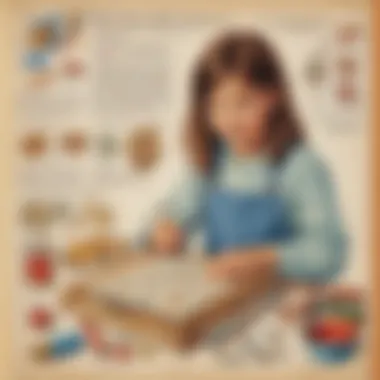
- Smooth stones (varying sizes)
- Acrylic paints or permanent markers
- Brushes (if using paints)
- Sealant (optional, for outdoor display)
Steps to Follow:
- Gather Rocks: Find smooth, flat stones that are easy to paint on.
- Design the Animals: Plan what kind of animals the rocks will become. Kids can go for classic options like turtles, ladybugs, or even mythical creatures.
- Paint the Base Color: Start by painting the base color of the intended animal. Let it dry completely.
- Add Details: Once the base coat is dry, add details like eyes, spots, or other features using bright colors. Encourage using imagination to create unique designs.
- Seal if Desired: If these animals are to be displayed outdoors, consider sealing them with a clear varnish to protect the artwork from the elements.
"Creating rock animals not only stimulates creativity, it also encourages kids to observe different shapes and patterns found in nature."
This activity isn’t just about crafting; it can also lead to stories and games later. Children may invent adventures for their rock creatures, combining art with imaginative play. Overall, nature-based crafts provide both learning opportunities and fun, merging the essence of childhood with the beauty of the great outdoors.
Recycled Crafts
In a world increasingly aware of environmental issues, recycled crafts not only offer a great opportunity for creativity but also teach valuable lessons about conservation. Third graders can play an active role in reusing materials that might otherwise end up in landfills. This kind of crafting promotes resourcefulness and sparks discussions about sustainability, helping children appreciate the impact of their choices on the planet. Moreover, recycled crafts can be just as fun and vibrant as those made from new materials. Here are two engaging ideas that young crafters can dive into.
Crafting with Plastic Bottles
Plastic bottles are ubiquitous in today’s world. Instead of tossing them out after a single use, there’s a whole spectrum of craft projects that can breathe new life into these items. One simple and fun project is creating plant pots from plastic bottles. All it takes is a few steps:
- Gather Supplies: Grab some empty plastic bottles, scissors, soil, and seeds or small plants.
- Prepare the Bottles: Cut the bottle in half or leave the top on for a unique watering can or decoration.
- Decorate: Use paint or fabric to cover the outside of the bottle. This step lets kids express their individuality while also learning about design.
- Plant It: Fill with soil and plant seeds or place a small plant inside.
- Water: Remember to water and care for the plants, which teaches kids about responsibility and nurturing.
Creating these plant pots allows children to discover the joy of gardening and the process of growth, all while reducing waste. Furthermore, these pots can be personalized with drawings or stickers, making each one unique.
Cardboard Box Creations
Cardboard boxes are not just trash; they are a treasure trove waiting to be transformed! Kids can let their imaginations run wild with what they can create from these versatile materials. A popular project is making a cardboard castle, an exciting endeavor that involves:
- Collecting Boxes: Gather a range of boxes – different sizes work great here!
- Planning: Have the kids sketch out their castle idea on paper—this step helps them visualize the project.
- Cut and Assemble: With adult supervision, cut sections for towers, doors, and windows, then tape the boxes together to form the base.
- Decorating: Kids can paint the boxes or cover them with colored paper, adding decorations like flags and drawbridges.
- Role Play: Once built, these castles can become the backdrop for imaginative play, allowing children to free their creativity.
"Crafting with recycled materials opens conversations about sustainability and encourages children to think about their choices."
In summary, both plastic bottles and cardboard boxes present exciting possibilities for recycled crafts. Not only do these activities provide endless fun, but they also foster awareness of environmental issues and the importance of creativity in everyday life. By turning trash into treasure, kids learn to value their environment while developing practical crafting skills.
Seasonal Crafts
Crafting in tune with the seasons provides an exciting way for children to engage with nature and celebrate various holidays. Seasonal crafts not only add color and fun to a child's learning experience but also help them understand the cyclical nature of the environment. By focusing on crafts that correspond to specific times of the year, kids gain opportunities to explore themes of change and creativity while developing fine motor skills. It combines art with subtle lessons about nature and cultural traditions—an intersection where learning becomes enjoyable.
Spring-Themed Crafts
As the chill of winter melts away, spring bursts forth with an explosion of color and life. Spring-themed crafts capitalize on this vibrant renewal. One excellent project involves creating flower bouquets using tissue paper.
To start, children can tear tissue paper into squares, then fold and twist them to mimic petals. Sticks or straws can serve as stems when they are attached to the tissue paper blooms. This engaging activity allows third graders to express their artistic flair while fine-tuning their hand-eye coordination.
Another simple yet enlightening craft is making seed paper. By mixing recycled paper with seeds and a bit of water, children create homemade paper that grows! Once dry, the paper can be planted in soil, and kids can watch their creations blossom. This blends creativity with an important lesson about the life cycle of plants.
Halloween Crafts
Halloween opens the door to a treasure trove of spooky and friendly craft ideas. One classic is making paper plate masks. Simple paper plates can transform into ghosts, goblins, or any friendly character thanks to some paint, scissors, and elastic bands. This craft encourages imagination and aids kids in expressing themselves while they work with various textures.
Creating pumpkin decorations is also a fun project. Instead of traditional carving, kids can paint mini pumpkins with vibrant colors or glue on fun embellishments like googly eyes or glitter. It's a safer alternative that allows for more creativity and minimizes mess, plus the painted pumpkins can adorn homes leading up to Halloween.
Winter Holiday Crafts
The winter months bring a sense of festivity and warmth. It's a time for gathering and sharing, where winter holiday crafts shine. One delightful project is crafting ornaments from various materials, such as felt or paper. Kids can cut out shapes like stars or snowflakes, decorate them with colors and glitter, and then hang them on the tree. The act of making these decorations creates lasting memories while allowing children to practice their crafting skills.
Another fun craft is constructing a winter scene in a jar. Using cotton balls to depict snow, small figurines, and even some glitter for an added frosty effect can create a miniature wonderland. This project holds special appeal as children can give their creations as gifts or use them to beautify their living spaces during the holidays.
Seasonal crafting provides children an enriching way to connect with their environment and celebrate different cultures, enhancing their creativity in multiple dimensions.
Crafts Incorporating Learning
Crafting isn't just about creating something visually appealing; it can also serve as a fantastic platform for learning essential skills. When children engage in crafts that incorporate learning, they are not only enhancing their creativity but also solidifying their grasp of various subjects in an interactive manner. This section explores how crafting can be a bridge to math and science, making these subjects more relatable and fun for third graders.
Math in Art: Shapes and Patterns
The world around us is filled with shapes, and introducing these in a fun crafty way makes math much less intimidating for kids. In projects that involve shapes and patterns, children can actively explore the basic concepts of geometry. For instance, using colored paper, kids can create mosaic art.
- Start with a discussion about shapes: Before starting the project, engage the kids in a conversation about different shapes—circles, squares, triangles—what they look like, and where they might find them in everyday life. This not only builds vocabulary but also sets the stage for what’s to come.
- Crafting the mosaic: Each child can grab scissors and paper to cut out various shapes. This hands-on activity allows them to physically manipulate the shapes, thus reinforcing their understanding. Once they have a collection, they can start arranging them on a piece of cardstock to create a design.
- Pattern recognition: Encourage them to think about patterns when placing shapes. For example, they might alternate between squares and circles or create a pattern of varying sizes. This process helps in recognizing sequences and fosters logical thinking—two significant math skills.
Using math in art tackles two subjects at once, making connections that enhance learning while having fun. It’s a win-win! Just remember, craft time has the added benefit of tuning fine motor skills, which is essential in both crafting and math tasks.
Science Exploration through Crafts
Science can sometimes feel like abstract concepts locked away in textbooks. But when paired with crafts, especially in a hands-on format, it takes on a whole new life. Children get to explore scientific principles through creativity, making learning meaningful and memorable.
A great example here could be creating a simple weather station. This project not only challenges their craft skills but also ignites curiosity about the natural world.
- Materials needed: Gather a plastic bottle, a notepad, a pen, and some items for measuring—like a ruler for wind speed.
- Building the station: Kids can transform the plastic bottle into a rain gauge or a wind vane with some guidance. They can decorate it with colored paper to personalize their weather monitoring instrument. This allows for a playful interaction with the material, transforming the educational process.
- Observation and recording: As they use their creation to observe changes in weather, children are actively engaging in scientific methods—hypothesizing, experimenting, and recording data. They can sketch clouds, note temperatures, and predict weather conditions. This hands-on experience fosters a genuine interest in science while developing critical observational skills.
"Crafting empowers children to see how subjects they learn in school can materialize in their daily lives."
Incorporating academic themes into crafts not only nurtures skills in areas like math and science but also promotes a love for learning. Instead of being confined to a classroom, education extends to the crafting table, where exploration and discovery meet creativity.
Safety Considerations
When it comes to crafts for third graders, safety should always be at the forefront of our minds. While crafting can be a fulfilling and enriching experience, there are aspects that require careful consideration. Ensuring that young crafters have a safe environment helps them focus on creativity without the worry of accidents. By recognizing the possible hazards and implementing protective measures, caregivers can create a positive atmosphere that allows kids to explore and express their artistic talents.
Age-Appropriate Tools and Materials
Selecting the right tools and materials isn’t just about sparkly papers or glue sticks. It’s essential to choose items that are designed with the age group in mind. Ask yourself, "Are the tools easy to handle? Are they safe for little fingers?" Here are some guidelines to keep in mind when gathering supplies for crafts:
- Child-Safe Scissors: Opt for scissors that have rounded tips to prevent any unfortunate nicks or cuts. These are not only safer but often still effective for cutting paper and lightweight materials.
- Non-Toxic Glue: Many glues are made with harmful chemicals. Look for options that are labeled non-toxic and washable. This offers peace of mind if the kids get a little messy.
- Crafting Kits: Pre-packaged craft kits often come with age-appropriate items. They usually include directions and provide what kids need to create a project safely.
"Safety is not a gadget but a state of mind."
— Eleanor Everet
By focusing on tools that are suitable for their developmental level, you can ensure that the crafting session flows smoothly while minimizing the risk of injury.
Supervision During Crafting
Even the best tools can’t replace the value of adult supervision. Children might not always realize the potential dangers of certain materials or mishaps that can easily occur when engaged in creative projects. Here’s how adult oversight can enhance the crafting experience:
- Guiding Proper Use: Kids might need reminders on how to handle tools correctly. A supervising adult can provide feedback, demonstrating how to safely perform tasks.
- Immediate Assistance: Accidents can happen, even with the most cautious of crafters. Having an adult nearby allows for quick responses in case of minor injuries or messes.
- Encouraging Safe Practices: Teaching children to clean their work area or put away tools when they’re done not only instills responsibility but also promotes a culture of safety.
Maintaining supervision isn’t about limiting creativity; it’s about nurturing a safe space for kids to explore their interests. With the right support in place, crafting can be a joyous and safe undertaking where learning happens naturally.
Encouraging Creativity
Fostering creativity in third graders is not just a nice touch; it's essential for their overall development. It fuels imagination and cultivates problem-solving skills. When kids engage in crafts, they step outside the box, allowing themselves to explore different materials and techniques. Every project becomes a canvas for their thoughts and feelings, and this kind of self-expression is vital at this stage of their lives.
Promoting Individual Expression
When a child creates, they put a piece of themselves into their work. Crafting provides an important avenue for individual expression, helping kids develop their own voice. Allowing them the freedom to choose colors, shapes, and styles means they can convey their personalities through their art. For example, a simple painting project can turn into a reflection of their experiences, emotions, and even the world around them.
The idea here is to encourage kids to think outside the norm. Rather than adhering strictly to pre-defined templates, invite them to experiment with their own ideas. Saying something like, "What would your dream world look like in a drawing?" can spark imagination.
Encouraging children to personalize their work also bolsters their confidence. When they take ownership of a creation, there’s a sense of achievement that can only come from expressing one’s self. When they finish a drawing or a craft project that they chose the elements for, it’s not just a piece of paper anymore; it’s a piece of their individuality.
Crafting as a Group Activity
Creative projects can also bloom when done in a group setting. Crafting as a team allows children to learn from each other. It's a beautiful thing when one child’s inventive idea inspires another to try something they wouldn’t have otherwise considered.
Working together on crafts encourages collaboration and teamwork. Kids learn to share supplies, take turns, and discuss ideas. Take a simple project, like making holiday decorations; one child may have a knack for designing while another might excel at assembly. This skills sharing can lead to impressive results, making the overall crafting experience rich and rewarding.
Setting up a group crafting session can also introduce a bit of friendly competition. You might have them create their own takes on a theme, and at the end, everyone can share their work. The discussions that follow can lead to deeper understanding and appreciation of each other’s creativity.
"Crafting together not only builds friendships but also nurtures a support system for creative growth."
Overall, the importance of encouraging creativity in crafts cannot be overstated. It's about creating environments where kids feel mentally safe and free to express themselves without fear of judgment. The skills they learn through crafting—whether alone or in a group—will stay with them long after they have moved on to other interests.
Creating space for their creativity can be as simple as providing them the right tools and saying,
"Show me what you can do!"
This not only enhances their crafting experience but lays the foundation for lifelong artistic skills.
Ending
In concluding this guide, it's essential to understand the impact of engaging in crafts, especially for third graders. Crafting is not just about creating projects; it’s about fostering personal growth, creativity, and learning in a fun and enjoyable way. For young kids, each craft cross-stitches skill development with imaginative play. Considerable benefits arise from crafting activities, such as improving fine motor skills, promoting concentration, and encouraging self-expression.
Recap of Craft Ideas
Throughout this article, various easy and accessible crafting ideas have been suggested, each tailored for third-graders. Here’s a quick refresher:
- Paper Crafts: Origami projects, collages, and greeting cards were discussed—methods that develop creativity while making good use of materials found at home.
- Nature-Based Crafts: Leaf prints and rock animals offer an opportunity for children to engage with nature while exploring their artistic side.
- Recycled Crafts: Projects using plastic bottles or cardboard boxes not only foster creativity but also promote the importance of recycling and environmental awareness.
- Seasonal Crafts: Crafting related to different seasons helps children understand and celebrate the changes in nature, from Spring-themed pieces to Winter holiday decorations.
- Educational Crafts: Incorporating math and science in crafts turns learning into a hands-on experience, making abstract concepts more tangible.
Each idea is designed not simply as a standalone project, but as a springboard for deeper exploration and learning. The focus is on having fun while crafting, as enjoyment often leads to better focus and improved skills, just as much as the act of crafting itself.
The Long-Term Benefits of Crafting
Crafting is not merely trivial. The long-term benefits of involving children in crafts are profound. Beyond the immediate joy of creating something, crafting enhances several vital life skills.
- Problem-Solving Skills: Whether it's figuring out how to assemble a craft or how to overcome a mistake, children learn resilience and critical thinking.
- Collaborative Abilities: When kids craft together, they learn teamwork. Sharing tools, ideas, and space leads to better communication.
- Emotional Benefits: Creating can be highly therapeutic. It’s a way for children to express feelings and handle emotions in an inventive way, which can be particularly helpful during social pressures and educational challenges.
- Cognitive Growth: Crafts often involve following instructions, measuring materials, and planning steps that enhance cognitive skills and retention of knowledge over time.
In essence, crafting nurtures a holistic growth environment, preparing third graders for future challenges while allowing them to explore and express their own creativity in a safe space. Keeping these benefits in mind can assist parents and caregivers in cultivating an enriching crafting experience.







